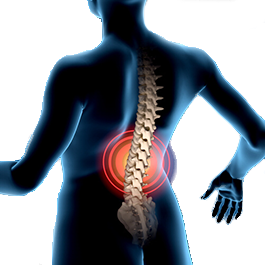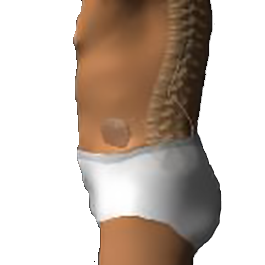Neurostimulation
 Percutaneous minimum invasive pain management technique is part of continuous strategy of permanent pain treatment that is widely use in nova days implanting the leads into epidural space and connecting them to subcutaneously positioned of spinal cord stimulator.
Percutaneous minimum invasive pain management technique is part of continuous strategy of permanent pain treatment that is widely use in nova days implanting the leads into epidural space and connecting them to subcutaneously positioned of spinal cord stimulator.
A Spinal Cord Stimulation System applies electrical current in the form of short bursts or pulses to a specific area of the spinal cord. This occurs between the negative and positive electrodes of the lead. Flow of electrons, known as electrical current, requires a complete electrical circuit, which consist of a power source (generator), a conductor (SCS lead), and resistance to flow or impedance (causes by wires and body tissue).
Stimulation is the depolarization of neural tissue resulting in propagation of action potential. The response of neural tissue to stimulation differs for different components and the spinal cord is very much affected by the stimulation and therefore the pain sensation subsides.
Characteristics of Therapeutic Effects of Spinal Cord Stimulation:
- Spinal Cord Stimulation is applied with low intensity and generally with 50-70 Hz and pulse width of 0.2-0.5 msec.
- Stimulation-evoked parasthesia must cover entire painful area.
- Spinal Cord Stimulation must be applied continuously for period of at least 20-30 minutes.
- The pain relieving effect usually develops slowly after 5-10 minutes.
- The pain relieving effect usually last for 20 minutes t0 3 hours after cessation of stimulation.
- Spinal Cord Stimulation is most effective for continuous chronic pain.
- Effective pain relief with Spinal Cord Stimulation is also occurring in cases of chronic neuropathic pain and chronic nociceptive pain.
- Allodynia and dysesthesia as the signs of Reflex Sympathetic Dystrophy Syndrome also effectively alleviated with Spinal Cord Stimulation.
Mechanism of Action of Spinal Cord Stimulation:
Spinal Cord Stimulation was introduced as a direct application of the Gate Control Theory. The Gate Theory postulates that large pain fibers are the ŌĆśgood guysŌĆÖ and small pain fibers are the ŌĆśbad guysŌĆÖ in signaling pain. However, it is evident that the large fibers respond best to Spinal Cord Stimulation and relieving pain sensation to abnormal functioning of large pain fibers. The pain relieve mechanism activated by Spinal Cord Stimulations would imply that both acute and chronic nociceptive and neuropathic pain should be suppressed.
Although the Gate Control Theory does not adequately explain the pain relieving mechanisms of Spinal Cord Stimulation, it is generally accepted that coverage of the pain areas directly related to the activation of the certain part of the Spinal Cord (dorsal column) which is a prerequisite for pain relief. On the other hands, Spinal Cord Stimulation reducing reactivity of sympathetic stimulation and depressing sympathetic hyperactivity.
The knowledgeable and thoughtful patient will appreciate the importance of as adequate trial prior to permanent implantation of the Spinal Cord Stimulator. Presently trial range from establishing concordant parasthesia in the operating room follows immediately by implantation, to tunneling Spinal Cord Stimulator lead followed by a several-day trial. Medical principles would suggest that the more closely the trial approximates the final status, the less likelihood there is of a false positive. In today days, Spinal Cord Stimulation is trialed percutaneously (through the skin without incision), with the lead subsequently removed and with a surgical lead placed after a period of reflection.
Implantable Pain Control System
Electrodes for Spinal Cord Stimulation System are inserted through an epidural needle under local anesthesia through the skin. The electrodes are then attached to battery-powered stimulator. Patient generally controls the strength and duration of stimulation once the optimal stimulating parameters have been identifies by the physician.
Spinal Cord Stimulation has been used for many patients with failed back surgery syndrome after laminectomy as an alternative to re-operation. It has also been used to treat Complex Regional Pain Syndrome (former Reflex Sympathetic Dystrophy), post herpetic neuralgia, spinal cord injury and many others.
Almost three decades of experience with Spinal Cord Stimulation for patients with chronic pain indicate continuous pain relief in over 80% of patients with long medical history. Objective evidence of pathology and of inadequate pain relief along with a specific pain diagnosis should be present before a trial of implantable pain therapy begins. It is usually use for chronic pain that spread to relatively large area such as lower back, neck, arms and legs. In general, if Neurostimulation can be utilized for a given pain syndrome, it is preferred and is attempted initially. When Neurostimulation is affective, it is requires less ongoing maintenance and expenses.
Traditionally, Neurostimulation was reserved as a late modality in the pain treatment continuum. However, neuroaugmentive treatment, such as spinal cord stimulation, can enhance multidisciplinary care by facilitating participation in activities, such as physical therapy, which is essential for rehabilitation.
 Medical Indications for Neurostimulation:
Medical Indications for Neurostimulation:
- Radiculopathies
- Post-Laminectomy Pain
- Multiple Back Operations
- Unsuccessful Disc Surgery
- Peripheral Causalgia
- Epidural Fibrosis
- Degenerative Disc Disease
- Herniated Disc PainRefractory to Conservative and Surgical Intervention
- Failed Back Surgery Syndrome
- Complex Regional Pain Syndrome
Epidural Blockade
 Fundamental to modern neural blockade as a treatment for pain is the concept that pain is a sensory warning conveyed by specific nerve fibers, amenable, in principle, to modulation or interpretation anywhere in the nerve pathway.
Fundamental to modern neural blockade as a treatment for pain is the concept that pain is a sensory warning conveyed by specific nerve fibers, amenable, in principle, to modulation or interpretation anywhere in the nerve pathway.
Blockade of large regions of the body by epidural and intrathecal administration of local anesthetics shares many of the characteristics of peripheral nerve blocks. Drugs applied epidurally reach their target tissues fast. No other neuronal blockade techniques are used as extensively as epidural blockage in each of the fields of surgical anesthesia, obstetric anesthesia, and diagnosis and management of acute and chronic pain.
Epidural blockade is also unique because of special features of the anatomic site of injection and the resultant diverse sites of action of the local anesthetic solution.
The most practical and widely used continuous method of neural blockade is epidural blockade with administration of drug that selectively block pain conduction, while leaving sensation, motor power and sympathetic function essentially unchanged.
The easiest and the safest point of entry into the epidural space is in the midlumbar region with the method of using simple surface landmarks with the indication of dermatomal blockade. The space usually permits easy injection of medication solution to block pain sensation.
With currently available local anesthetic agents, epidural neural blockade where sympathetic blockade accompanied by somatic blockade, which may involve sensory and motor blockade alone or in combination is very safe procedure. The essence of clinical pharmacology of epidural block known by your doctor is the provision of safe and effective neural blockade.
The sites of action of medications administered into the epidural space include the nerve trunks, the dorsal root ganglia, the dorsal and ventral spinal roots, the spinal cord itself and the brain.
There is no question that epidural block is effective in nearly all cases. Unfortunately, there are still many physicians and medical centers that hold the belief that epidural blockade have a high failure rate. Today, with an attention that is paying to the anatomy, physiology, pharmacology and technique of the procedure-the effectiveness of epidural injection as a treatment of pain is very well established. The use of epidural block in many thousand of patients with back pain and neurological deficit after surgery attests to its safety in selected patients with stable neurologic signs.